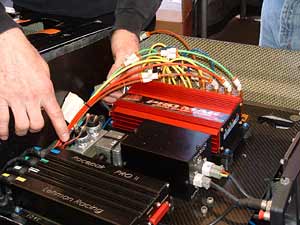
Unfortunately, drag racing's premier sanctioning bodies
and their drivers have paid a heavy price for those crowd-pleasing
performances. Exploding engines and tires and blowovers began
occurring more and more often as the speeds climbed and ET's
dropped.
Sanctioning bodies, team owners and drivers accepted the
increased danger that came with the ever-improving speeds
and elapsed times. The fact that a premier driver hadn't
ADVERTISEMENT
 |
suffered a career-ending injury or been killed lulled everyone
into a false sense of security. There were also financial
considerations because, make no mistake, all auto racing
and especially drag racing has depended on speed and the
inherent danger of the sport to attract fans. If that weren't
the case and all drag racing fans wanted to see was close
racing, the stands would be packed to watch 8.90/9.90 classes
at National events.
Just how important is performance to the commercial success
of IHRA and NHRA events? According to Rockingham Dragway's
owner/operator Steve Earwood, who has two IHRA National events
a year at his North Carolina track and formerly ran Billy
Meyer's Motorplex and worked for directly for the NHRA, performance
does convert to ticket sales.
"Every time a Funny Car or Top Fuel car runs a really
big number," Earwood said, "the next event on the
calendar, at every track I've been involved with, the phones
start ringing. Fans want to know if the car or driver that
ran the big number is coming and if so, how do they go about
purchasing a ticket."
Until the tragic death of driver Darrell Russell at NHRA's
St. Louis race last year everyone involved in professional
drag racing apparently felt the risk-reward factor involved
with nitro racing was acceptable. Russell's death may have
changed all of that forever.
In the weeks after that accident NHRA and IHRA took immediate
steps to both slow down nitro-burning cars and improve the
driver safety factor. The new rules for safety have been
universally embraced and there are more coming down the pipeline,
but the rules designed to slow down the fuel burners proved
totally ineffective, just as all the ones before them had.
For the 2005 season NHRA's advisor on nitro racers, Ray
Alley, on the directive of his bosses came up with a new
method that absolutely will slow down the nitro cars. It
is a device developed for NHRA by the MSD Ignition company
and it has already been tested and proven. According to NHRA
sources they will be on all fuel cars by the Gatornationals
at Gainesville, FL in March.

Here is the device itself with
the fickle finger pointing out the actual part. |
The device, which MSD developed and has incorporated into
their Pro Mag ignition system that virtually every Top Fueler
and Funny Car has, is a rev-limiter that will limit the max
rpm for fuel cars to 8400 rpm.
According to an engineer I spoke with at MSD, here is a
basic overview of how the device will work. It is designed
to be activated when the injector blades are wide open. After
a four-second delay the device begins monitoring crankshaft
speed and, if the RPM exceeds 8400, then the device will
drastically retard timing which is supposed to keep the engine
rpm from ramping up. The unit will cost the teams about $150.
It comes sealed from the factory and is non-adustible.

|
